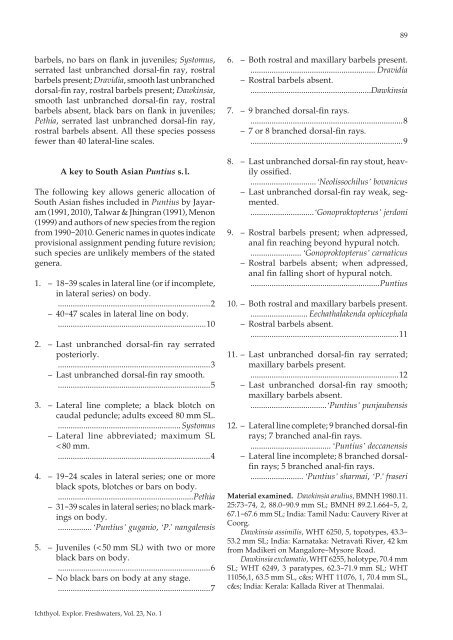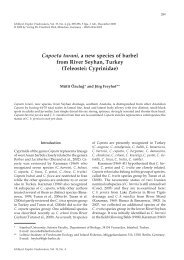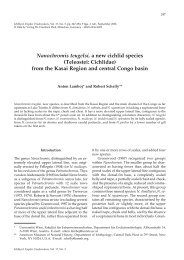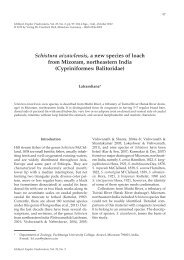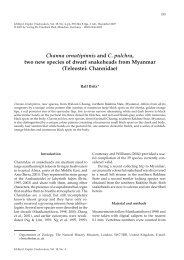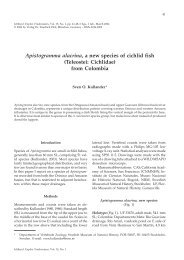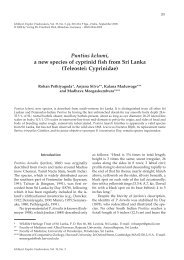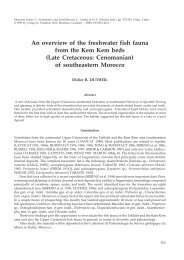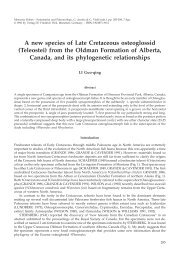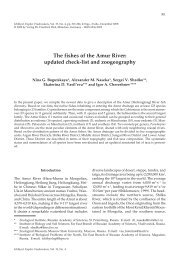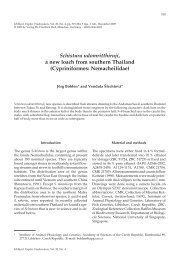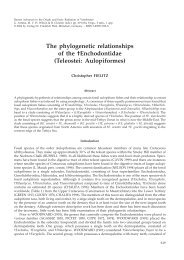A synopsis of the South Asian fishes referred to Puntius - Verlag Dr ...
A synopsis of the South Asian fishes referred to Puntius - Verlag Dr ...
A synopsis of the South Asian fishes referred to Puntius - Verlag Dr ...
Create successful ePaper yourself
Turn your PDF publications into a flip-book with our unique Google optimized e-Paper software.
arbels, no bars on flank in juveniles; Sys<strong>to</strong>mus,<br />
serrated last unbranched dorsal-fin ray, rostral<br />
barbels present; <strong>Dr</strong>avidia, smooth last unbranched<br />
dorsal-fin ray, rostral barbels present; Dawkinsia,<br />
smooth last unbranched dorsal-fin ray, rostral<br />
barbels absent, black bars on flank in juveniles;<br />
Pethia, serrated last unbranched dorsal-fin ray,<br />
rostral barbels absent. All <strong>the</strong>se species possess<br />
fewer than 40 lateral-line scales.<br />
A key <strong>to</strong> <strong>South</strong> <strong>Asian</strong> <strong>Puntius</strong> s. l.<br />
The following key allows generic allocation <strong>of</strong><br />
<strong>South</strong> <strong>Asian</strong> <strong>fishes</strong> included in <strong>Puntius</strong> by Jayaram<br />
(1991, 2010), Talwar & Jhingran (1991), Menon<br />
(1999) and authors <strong>of</strong> new species from <strong>the</strong> region<br />
from 1990-2010. Generic names in quotes indicate<br />
provisional assignment pending future revision;<br />
such species are unlikely members <strong>of</strong> <strong>the</strong> stated<br />
genera.<br />
1. – 18-39 scales in lateral line (or if incomplete,<br />
in lateral series) on body.<br />
........................................................................2<br />
– 40-47 scales in lateral line on body.<br />
......................................................................10<br />
2. – Last unbranched dorsal-fin ray serrated<br />
posteriorly.<br />
........................................................................3<br />
– Last unbranched dorsal-fin ray smooth.<br />
........................................................................5<br />
3. – Lateral line complete; a black blotch on<br />
caudal peduncle; adults exceed 80 mm SL.<br />
.......................................................... Sys<strong>to</strong>mus<br />
– Lateral line abbreviated; maximum SL<br />
< 80 mm.<br />
........................................................................4<br />
4. – 19-24 scales in lateral series; one or more<br />
black spots, blotches or bars on body.<br />
................................................................Pethia<br />
– 31-39 scales in lateral series; no black markings<br />
on body.<br />
................‘<strong>Puntius</strong>’ guganio, ‘P.’ nangalensis<br />
5. – Juveniles (< 50 mm SL) with two or more<br />
black bars on body.<br />
........................................................................6<br />
– No black bars on body at any stage.<br />
........................................................................7<br />
Ichthyol. Explor. Freshwaters, Vol. 23, No. 1<br />
89<br />
6. – Both rostral and maxillary barbels present.<br />
........................................................... <strong>Dr</strong>avidia<br />
– Rostral barbels absent.<br />
.........................................................Dawkinsia<br />
7. – 9 branched dorsal-fin rays.<br />
........................................................................8<br />
– 7 or 8 branched dorsal-fin rays.<br />
........................................................................9<br />
8. – Last unbranched dorsal-fin ray s<strong>to</strong>ut, heavily<br />
ossified.<br />
...............................‘Neolissochilus’ bovanicus<br />
– Last unbranched dorsal-fin ray weak, segmented.<br />
..............................‘Gonoprok<strong>to</strong>pterus’ jerdoni<br />
9. – Rostral barbels present; when adpressed,<br />
anal fin reaching beyond hypural notch.<br />
........................ ‘Gonoprok<strong>to</strong>pterus’ carnaticus<br />
– Rostral barbels absent; when adpressed,<br />
anal fin falling short <strong>of</strong> hypural notch.<br />
.............................................................<strong>Puntius</strong><br />
10. – Both rostral and maxillary barbels present.<br />
........................... Eechathalakenda ophicephala<br />
– Rostral barbels absent.<br />
......................................................................11<br />
11. – Last unbranched dorsal-fin ray serrated;<br />
maxillary barbels present.<br />
......................................................................12<br />
– Last unbranched dorsal-fin ray smooth;<br />
maxillary barbels absent.<br />
....................................‘<strong>Puntius</strong>’ punjaubensis<br />
12. – Lateral line complete; 9 branched dorsal-fin<br />
rays; 7 branched anal-fin rays.<br />
...................................... ‘<strong>Puntius</strong>’ deccanensis<br />
– Lateral line incomplete; 8 branched dorsalfin<br />
rays; 5 branched anal-fin rays.<br />
......................... ‘<strong>Puntius</strong>’ sharmai, ‘P.’ fraseri<br />
Material examined. Dawkinsia arulius, BMNH 1980.11.<br />
25:73-74, 2, 88.0-90.9 mm SL; BMNH 89.2.1.664-5, 2,<br />
67.1-67.6 mm SL; India: Tamil Nadu: Cauvery River at<br />
Coorg.<br />
Dawkinsia assimilis, WHT 6250, 5, <strong>to</strong>potypes, 43.3-<br />
53.2 mm SL; India: Karnataka: Netravati River, 42 km<br />
from Madikeri on Mangalore-Mysore Road.<br />
Dawkinsia exclamatio, WHT 6255, holotype, 70.4 mm<br />
SL; WHT 6249, 3 paratypes, 62.3-71.9 mm SL; WHT<br />
11056,1, 63.5 mm SL, c&s; WHT 11076, 1, 70.4 mm SL,<br />
c&s; India: Kerala: Kallada River at Thenmalai.


